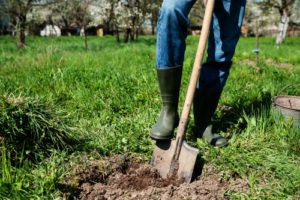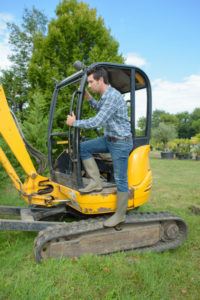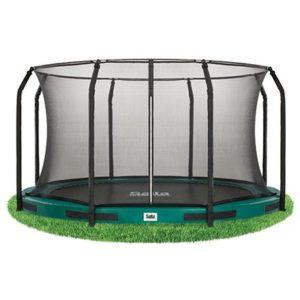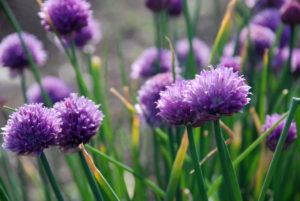Trampolin nedgravning: Sådan gør du! | Gode råd og vejledning til nedgravning af trampolin
Indholdsfortegnelse
Inden du kaster dig ud i trampolin nedgravning er er er flere ting du skal være opmærksom på. Læs hvorfor kanterne i hullet skal afstives, og få tips til hvordan du graver hullet. Bliver trampolinen gravet ned ordentligt fra start af, vil du få en sikker trampolin til haven, der kan holde i mange år.
Hvor skal trampolinen være?
Inden du går i gang med trampolin nedgravning skal du være sikker på, at du vælger det rette sted til din trampolin.
Det bedste sted til trampolin nedgravning er hvor græsset og jorden er jævn. Ungå at der er bakker eller store sten i området, der kan besvære gravearbejdet.

Sørg også for at der ikke er hårde sten i området, som børnene kan falde ud og slå sig på. Hvis du ikke har et blødt område, bør du ligge et faldunderlag rundt om trampolinen.
Kig op. Placer ikke trampolinen tæt på træer eller buske, som børnene kan ramme når de hopper. Så undgår du også for mange nedfaldne blade på trampolinen om efteråret.
Har du meget sandet jord i din have, kan det blive svært at grave et stabilt hul, der ikke falder sammen igen. Så er det en god idé at få en anlægsgartner med på råd, inden du går i gang.
Det skal du være opmærksom på
Grav forsigtigt, så du ikke får ødelagt kabler, rør eller ledninger hvis du graver. Det ville være uheldigt at ramme et gasrør med gravemaskinen. Du kan undersøge, hvor der er rør i jorden ved at kigge på din grundplan.
Sådan markerer du hvor du skal grave
Når du har fundet den perfekte placering til trampolin nedgravning i haven, kan du ligge dugen ud for at få et bedre indtryk af hvordan det ser ud.
Skal du nedgrave en rund trampolin ned, kan du markere området ved at slå en lille træpæl ned i midten, og binde en snor på svarende til trampolinens radius. Nu kan du markere en cirkel. Brug enten en spray til formålet, eller grav en lille rende rundt for at markere.
Skal du nedgrave en firkantet trampolin, så marker hjørnerne med små træpæle.
Derfor skal du grave trampolinen ned
- Øget sikkerhed. Børnene kan ikke falde ned fra trampolinen, når den flugter med græsset
- Vælter ikke i storm. De kraftige efterårsstorme, der har ramt Danmark de seneste år har fået en del trampoliner til at vælte og forsage skader. Det undgår du med en nedgravet trampolin, hvor vinden ikke kan få fat på samme måde.
- Skal ikke flyttes, når græsset skal slåes. Undgå at flytte rundt på den tunge trampolin, for at få styr på det lange græs under den.
- Tager ikke udsynet. Undgå en stor klodset trampolin i landskabet, der skygger for dine blomsterbede eller flotte udsigt.
Trampolin nedgravning: Sådan graver du nemmest hullet
Nu skal du i gang med at grave hullet. Det kan godt være hårdt og tidskrævende at grave hullet med en skovl og håndkraft. Lej en bobcat i dit lokale byggemarked. Du kan få den leveret på din adresse og afhentet igen.
 Det er vigtigt, at hullet bliver dybt nok. Læs i vejledning til den nedgravningstrampolin, som du har købt. Trampolindugen skal være på samme niveau som græsplænen.
Det er vigtigt, at hullet bliver dybt nok. Læs i vejledning til den nedgravningstrampolin, som du har købt. Trampolindugen skal være på samme niveau som græsplænen.
Der skal være luft omkring trampolinen, og hullet skal være dybt nok til at trampolinen ikke kan ramme jorden, når der hoppes på den. Minimumsdybden skal være omkring 1 meter, men vil variere alt efter hvilken trampolin du skal grave ned.
Sørg for rigelig af plads i siderne af hullet. Lav bunden af hullet så vandret som muligt. Trampolinens ben skal placeres på fliser i bunden, så den står solidt og vandret.
Grav hullet, så der er en lille hældning på kanterne. Hvis kanterne er helt lodrette, er de svære at afstive. Læs mere om afstivning af kanter i næste afsnit.
Derfor skal kanterne i hullet afstives
Sikkerheden er vigtig, når det kommer til trampolin nedgravning.
Hvis kanterne og bunden af hullet ikke er afstivet, risikerer du at der ryger løs jord ned i bunden, og hullet pludselig ikke længere og dybt nok. Det kan være farligt, hvis trampolindugen kan ramme jorden, når børnene hopper.
Kanterne afstives bedst med støttemursfliser. De lægges fast med en cementblanding. I bunden kan du ligge en fiberdug, som forhindrer ukrudt i at vokse op under trampolinen. Er du i tvivl om hvordan man afstiver kanterne, så tag kontakt til en anlægsgartner, eller spørg i et byggemarked.
Køb støttemursfliser billigt her.
Køb fiberdug til 49,95 kr. til bunden af hullet her.
Placer trampolinen i hullet
Trampolinen skal stå helt vandret og stabilt, når den er placeret i hullet. Inden trampolinen tages i brug, så gennemgå den grundigt hele vejen rundt og sørg for at man ikke kan ramme fliserne eller jorden, når man hopper i siderne af trampolinen.
Trampolin til nedgravning
Vil du have en ekstra sikker trampolin, kan du anskaffe dig et sikkerhedsnet til den nedgravede trampolin. Sikkerhedsnettet forhindrer at børnene kan hoppe uden for trampolinen.
Derudover kan de små børn ikke selv kravle ind på trampolinen og begynde at hoppe uden opsyn.
Vælg den rette trampolin til nedgravning
Denne trampolin til nedgravning har en kraftig kantmåtte, et stærkt sikkerhednet og de bedste fjedre der giver den bedste hoppeoplevelse.
Normalprisen for denne Berg trampolin er 4.999 kr. Køb den her.
Mål: 3,66 meter i diameter.
Trampolinen er fra mærket Berg, der har mere end 30 års erfaring med at producere de sikreste og bedste trampoliner.
Anbefalet alder: fra 3 år.
Se flere trampoliner her.
Husk dette når du arbejder – Pas på din krop
Sørg for at have en ordentlig arbejdsstilling. Din næse og skosnuder skal vende samme vej, så du undgår vrid i kroppen. Hold også pauser i arbejdet.
Graver du med gravko, så hav altid styr på hvor dine børn er, så du ikke risikerer at de løber rundt og leger i nærheden af arbejdet.
Brug også solcreme, så du undgår at blive forbrændt. Især om foråret, hvor UV indexet er højt.
Det kan du bruge det overskydende jord til
Når du er færdig med det hårde arbejde, står du med en bunke jord. Der er ingen grund til at bruge tid og energi på at skille sig af med, det når det nemt kan bruges andre steder i haven.

- Lav smukke højbede. Brug jorden til at lave de højbede i haven, som du altid har drømt om. Højbede er med til at skabe opdeling og harmoni i haven, og er gode i køkkenhaven.
- Lig jorden bagerst i haven som en kompostbunke. Få din helt egen miljøcentral. Jord blandet med blade i en kompostbunke bliver med tiden til dejlig blød muld.
- Brug jorden til en høj til børnene. De fleste børn vil elske at kravle op og ned af en jordhøj.
Kilder:
Carsten Nielsen, gartner igennem 42 år, og erfaring med trampolin nedgravning
Bolius – Boligejernes videnscenter


